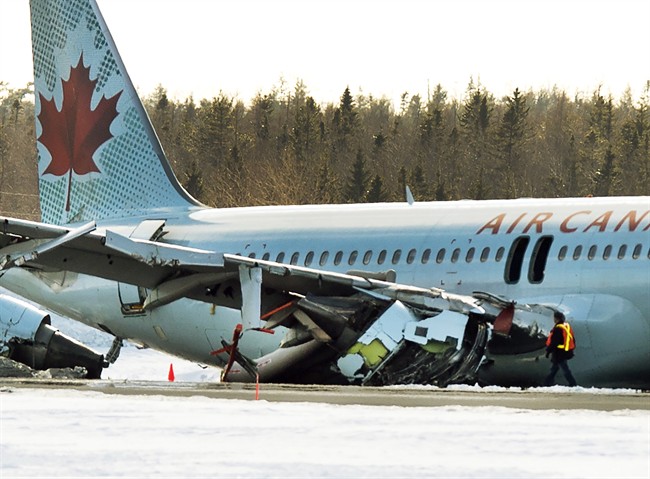HALIFAX – The Transportation Safety Board of Canada says it has concluded its site examination at Halifax’s Stanfield International Airport following the crash landing of Air Canada flight 624 on Sunday.

The TSB said Tuesday afternoon it was also authorizing the removal of the Airbus A320 aircraft, but will maintain custody of the plane as its investigation continues.
The plane is expected to be removed from the runway within the next few days.
Flight AC624 touched down 335 metres short of the runway at about 12:45 a.m. on Sunday. All 133 passengers and five crew on board the Airbus A320 survived the crash, although 25 people were sent to hospital.
READ MORE: Timeline of Air Canada flight 624 crash
Meanwhile. the airport authority is trying to determine why two generators failed to provide power to its terminal building Sunday morning after the flight crashed, while another generator that keeps the airfield lights on didn’t fail.
In a statement Tuesday updating its response to the crash, airport authority president Joyce Carter also says it will likely be at least a month before the runway where the plane crashed is operational again.
WATCH: Raw video of Air Canada flight 624 off the runway at Halifax International Airport
Carter says two generators that work in tandem to supply electricity to the terminal building came on but shut down shortly after. A third generator dedicated to the airfield kept running.
“This means that there was virtually no interruption in airfield lighting,” Carter says.
Carter says the crash resulted in the main feed from Nova Scotia Power being cut, and full power was restored before 2 a.m.
The airport has been criticized by passengers about its response to the crash. Carter said the authority began an internal review Tuesday morning looking at how it responded.
READ MORE: Crash landing: How do airplane accidents affect survivors’ mental health?
Some passengers said they waited for more than an hour for emergency responders to help them as they stood outside in the midst of a snowstorm. The airport has said passengers were waiting up to 50 minutes for help.
Carter says first responders arrived at the scene almost two kilometres away within 90 seconds.
“Their immediate task was to ensure the plane was fully evacuated and then to take on the challenge of mitigating any chance of fire or explosion,” she says.
The plane landed on runway 05, which is now in the hands of the TSB as it continues its investigation.
READ MORE: A look at Air Canada’s safety record
Carter says the airport will have to do an assessment of damage to the runway and begin clean up with Air Canada, which could take several days. It will take longer for NavCanada to replace navigational aids that were damaged by the Air Canada plane, says Carter.
The safety board has said when the plane touched down short of the runway it hit an antenna array and lost its landing gear.
The board said the plane became airborne again after it first touched down, leaving an extensive debris field between the antenna and the start of the runway.
The plane slid for another 335 metres down the runway on its belly before coming to a stop.
The board declined an interview request on Tuesday.


Comments